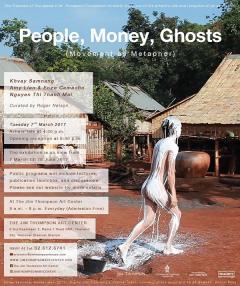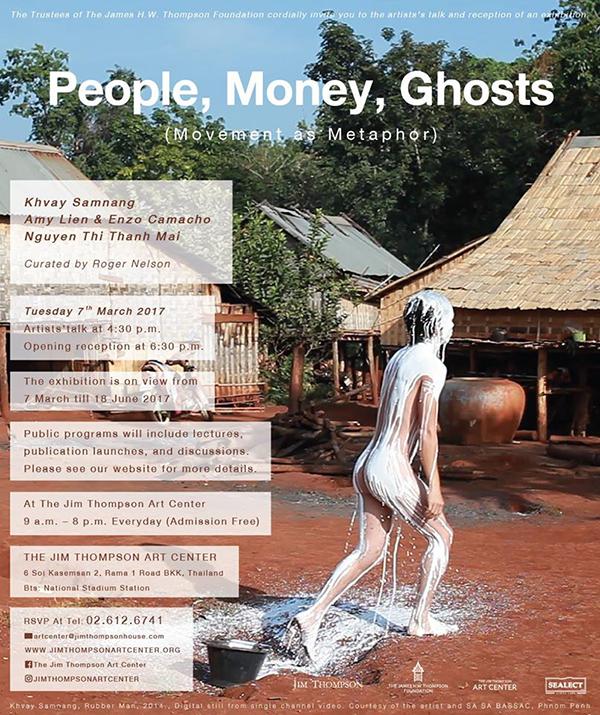นิทรรศการ "People, Money, Ghosts (Movement as Metaphor)"

นิทรรศการ "People, Money, Ghosts (Movement as Metaphor)" ผลงานโดย ไขว สัมนาง (Khvay Samnang), เอมี เลียน(Amy Lien), เอ็นโซ คามาโช (Enzo Camacho) และ เหงียน ธี ธันห์ ไม (Nguyen Thi Thanh Mai) จัดแสดงระหว่างวันที่ 7 มีนาคม - 18 มิถุนายน 2560 และจะมีพิธีเปิดในวันที่ 7 มีนาคม เวลา 18.30 น. ณ หอศิลป์บ้านจิม ทอมป์สัน : The Jim Thompson House
นิทรรศการกลุ่มแสดงผลงานศิลปะโดย: ไขว สัมนาง (พนมเปญ) / เอมี เลียน &เอ็นโซ คามาโช (มะนิลา, เบอร์ลิน และนิวยอร์ก) / เหงียน ธี ธันห์ ไม (เว้)
คัดสรรโดย โรเจอร์ เนลสัน(พนมเปญ)
ณ หอศิลป์บ้านจิม ทอมป์สัน, กรุงเทพมหานคร
7 มีนาคม ถึง 18 มิถุนายน 2560, เปิดให้เข้าชมทุกวัน 9.00 – 20.00 น.
เสวนากับศิลปินและภัณฑารักษ์ ในวันอังคารที่ 7 มีนาคม เวลา 16.30 น.
พิธีเปิดนิทรรศการวันที่ 7 มีนาคม เวลา 18.30 น.People, Money, Ghosts (Movement as Metaphor) เป็นนิทรรศการมุ่งสำรวจว่าการเดินทางกับการอพยพของประชากรและอุตสาหกรรมทั้งหลาย แนวคิดทฤษฎีกับความเชื่อทางจิตวิญญาณ สุนทรียะกับวิทยาการ และตัวศิลปินเอง มีส่วนสร้างโลกของเราขึ้นใหม่อย่างต่อเนื่อง – ทั้งภายในและนอกเหนือภูมิภาคที่เราเรียกว่าเอเชียตะวันออกเฉียงใต้ – และภาวะดังกล่าวปรากฏชัดในการสร้างผลงานของศิลปินผู้แสดงงานครั้งนี้อย่างไร นิทรรศการนี้จึงเกี่ยวกับกระบวนการของการเคลื่อนย้ายด้วยตัวนิทรรศการเองเฉกเช่นบานพับที่พลิกแพลงได้หลายทิศทางโดยขึ้นกับตัวงานศิลปะแต่ละชิ้น มากกว่าตัวคำถามภายในชิ้นงานที่เปล่งเสียงได้ทั้งที่นี่และทุกหนแห่ง ผลงานจัดแสดงทั้งหมดของล้วนสร้างขึ้นในพื้นที่ห่างไกลความคุ้นชิน กล่าวคือไม่ใช่เมืองอันเป็น ‘บ้าน’ ของศิลปิน และต่างได้รับอิทธิพลจากความหมายจำเพาะของพื้นที่ทั้งในแง่มุมเชิงประวัติศาสตร์กับโลกร่วมสมัย ผลงานในนิทรรศการคำนึงถึงการเคลื่อนย้ายทั้งในฐานะประสบการณ์และวัตถุแห่งการสืบค้นวิจัยทางศิลปะ ศิลปินแต่ละคนเลือกคำถามและประเด็นซึ่งเชื่อมโยงกับการไร้ถิ่นฐานของผู้คน ความพลิกผันเปลี่ยนแปลงในเมืองหลวงของดินแดนอื่น และผลกระทบสืบเนื่องอันหลอกหลอนของสิ่งเหล่านั้น ในฐานะร่องรอยทางประวัติศาสตร์ในพื้นที่ร่วมสมัย พื้นที่ในความสนใจเหล่านี้จึงเป็นกระจกส่องสะท้อนทั้งประสบการณ์ส่วนตัวในการเคลื่อนย้ายถิ่นฐานของศิลปินและกระบวนการทำงานของพวกเขา
People, Money, Ghosts (Movement as Metaphor) เป็นนิทรรศการที่ตั้งคำถามถึงความเป็นไปได้ ในการจินตนาการถึงและหาเหตุผลให้กับโลกที่เลื่อนไหลเปลี่ยนแปลงอย่างต่อเนื่องตลอดเวลา ประหนึ่งกลุ่มดาวของชิ้นส่วนเคลื่อนไหวที่ปรับสร้างรูปแบบใหม่ไม่รู้จบ และกลุ่มพลังกับรูปแบบอันยุ่งเหยิงสับสนที่ลุกลามขยายตัวเหล่านี้ไม่ใช่สิ่งที่จะทำความเข้าใจได้หมดจดจากเพียงมุมมองเดียว การเปลี่ยนแปลงไปมาระหว่างแต่ละสถานที่และการเคลื่อนไหวผ่านพื้นที่ กลายเป็นใจความสำคัญในการสร้างงานศิลปะของศิลปินกลุ่มนี้ การย้ายที่อยู่เป็นกิจวัตรกลายเป็นสภาวะแวดล้อมที่จำเป็นสำหรับพวกเขา ศิลปินทั้งหมดได้เสนอให้มองภูมิภาคนี้ในฐานะเครือข่ายความสัมพันธ์อันเปี่ยมพลวัตที่การกำหนดค่าหรือรูปแบบนั้นเปลี่ยนแปลงอยู่ตลอดเวลา และกระหายอย่างยิ่งที่จะโดดข้ามพรมแดนของรัฐชาติภายใต้เอเชียตะวันออกเฉียงใต้ รวมถึงพรมแดนในจินตกรรมของตัวภูมิภาคเองอีกต่อหนึ่ง
เกี่ยวกับผลงานที่จัดแสดงในนิทรรศการ
โปรเจ็คต์ทั้งสองของ ไขว สัมนาง (Khvay Samnang) มุ่งสำรวจการเคลื่อนย้ายในบริบทของประเทศกัมพูชาที่ขยายใหญ่ขึ้น – Yantra Man (2015) เป็นการสำรวจประวัติศาสตร์ที่ถูกหลงลืมในวงกว้างเกี่ยวกับทหารกัมพูชาผู้ถูกส่งไปร่วมรบให้กองทัพฝรั่งเศสในสงครามโลกครั้งที่หนึ่ง ตัวงานประกอบด้วยการจัดวางประติมากรรมเหล็ก โดยโมทีฟที่ปรากฏในชิ้นงานคือพระเครื่องที่เป็นเครื่องรางและผ้ายันต์แบบเขมร ตัวงานมุ่งพิเคราะห์การสะท้อนไปมาระหว่างประสบการณ์ในประวัติศาสตร์ของเหล่าทหาร และประสบการณ์ร่วมสมัยของคนที่ต้องทำงานไกลบ้าน – Rubber Man (2014) ประกอบด้วยวิดีโอหนึ่งจอที่บันทึกการแสดงของตัวศิลปิน และจัดวางบนประติมากรรมไม้ที่นำเสนอบนดินร่วนแดง ชนิดเดียวกับที่พบได้ในจังหวัดรัตนคีรีทางตอนเหนือของประเทศกัมพูชา งานชิ้นนี้สำรวจผลกระทบทั้งทางสิ่งแวดล้อม สังคม และจิตวิญญาณ ของการเพาะปลูกยางพาราในพื้นที่ดังกล่าว
ศิลปินคู่ เอมี เลียน & เอ็นโซ คามาโช (Amy Lien &Enzo Camacho) ร่วมกันเสนอผลงานชุดใหม่ด้วยรูปแบบที่เธอและเขาเรียกว่า ‘ประติมากรรมวิดีโอ’ (video sculpture)– งานศิลปะชุดนี้สำรวจรูปลักษณ์และตัวตนของสิ่งคล้ายผีที่มีผู้พบเจอตามพื้นที่ต่างๆ ทั่วทั้งเอเชียตะวันออกเฉียงใต้ สิ่งมีชีวิตในตำนานที่แยกร่างโดยทิ้งส่วนขาไว้ในป่า (ทั้งในความหมายตรงตัวและโดยเปรียบเทียบ) ในขณะที่ส่วนหัวกับเครื่องในบินผ่านเมืองสร้างความตื่นกลัวให้ชาวบ้าน ในไทยเรียกสิ่งมีชีวิตนี้ว่ากระสือ (krasue) ในขณะที่กัมพูชาใช้ชื่อ เอิบ (arb) จุดเริ่มต้นความสนใจของศิลปินที่มีต่อร่างกลายพันธุ์ชนิดนี้คือ มานานังกาล (manananggal) ของฟิลิปปินส์ และศิลปินเลือกนำเสนอกระสือ/เอิบ/มานานังกาลในรูปสัญลักษณ์อย่างบทกวีที่สะท้อนสัมผัสของตัวตนที่ผันแปรไม่หยุดนิ่ง เป็นสัมผัสของตัวตนที่ไร้ศูนย์กลางตายตัว ตัวตนที่เคลื่อนย้ายอพยพมากกว่าสงบนิ่งที่ ‘บ้าน’ หรือสถานที่จำเพาะ และแข็งขืนต่อการจำแนกประเภทด้วยตรรกะและเหตุผล ศิลปินเสนอว่าสิ่งมีชีวิตนี้ถือเป็น ‘สัตว์ประหลาดโอเพ่นซอร์ส’ (open-source monster) โดยหยิบยืมคำศัพท์ที่สื่อความถึงซอฟต์แวร์ที่เกิดขึ้นจากความร่วมมือระหว่างผู้ผลิต และ/หรือพัฒนาต่อโดยผู้ใช้ มาช่วยอธิบายคุณลักษณะ–ชิ้นงานทั้งสามที่แยกส่วนชัดเจนทว่าสัมพันธ์ซึ่งกันและกัน (และโต้ตอบระหว่างกันอย่างเงียบเชียบ) สร้างขึ้นใหม่เพื่อนิทรรศการครั้งนี้โดยเฉพาะ
Day by Day (2014-7) โดยเหงียน ธี ธันห์ ไม (Nguyen ThiThanh Mai) สำรวจประสบการณ์ผู้อพยพของชุมชนชาวเวียดนามไร้รัฐที่ใช้ชีวิตในหมู่บ้านลอยน้ำในประเทศกัมพูชาและเวียดนาม ชุมชนดังกล่าวต้องประสบความยากแค้นนานหลายทศวรรษ ทั้งถูกกวาดล้างระหว่างช่วงสงครามอเมริกันในเวียดนามและภายใต้การปกครองของเขมรแดงในกัมพูชา และถูกปฏิเสธสิทธิมนุษยชนอย่างต่อเนื่องทั้งการศึกษาและสาธารณสุขขั้นพื้นฐาน อันเป็นผลสืบเนื่องจากการไม่สามารถเข้าถึงเอกสารยืนยันตัวตนทางกฎหมายในแต่ละชาติ โปรเจ็คต์นี้ประกอบด้วยวิดีโอความยาวหนึ่งชั่วโมง จัดวางร่วมกับ ‘บัตรประชาชน’ ปลอม และชุดคอลลาจภาพถ่ายดิจิตอลติดตั้งในกระท่อมทางมะพร้าวหลังเล็กที่สร้างขึ้นในพื้นที่ของแกลเลอรี
ผลงานทุกชิ้นที่จัดแสดงคราวนี้ล้วนมีศักยภาพในการสะท้อนเข้าหาสภาพแวดล้อมร่วมสมัย และเรื่องเล่าทางประวัติศาสตร์ของประเทศไทยที่จมอยู่ใต้พื้นผิว ศิลปินในไทยจำนวนมากเองก็รับเอาวิถีปฏิบัติเยี่ยงผู้อพยพหรือชนเผ่าพเนจรไว้กับตัว ซึ่งโดยปริยายพวกเขาได้สำแดงปลดเปลื้องให้เห็นความรู้สึกของประสบการณ์ในระดับภูมิภาค (pan-regional) เอเชียตะวันออกเฉียงใต้ที่ซุกซ่อนไว้ มากกว่าตัวตนที่มีเขตแดนจำกัดของชาติที่ตนเองสังกัดอยู่
เกี่ยวกับศิลปินและภัณฑารักษ์
ไขว สัมนาง (เกิดปี 2525, พำนักในพนมเปญ) คือหนึ่งในศิลปินสาขาทัศนศิลป์ที่มีชื่อเสียงที่สุดของประเทศกัมพูชา เขาทำงานทั้งด้านเพอร์ฟอร์มานซ์, ภาพถ่าย, วิดีโอ, ศิลปะจัดวาง และยังสนอกสนใจสำรวจประเด็นชวนถกเถียงทั้งด้านการเมือง สังคม กับความเปลี่ยนแปลงทางวัฒนธรรม และเรื่องเล่าทางประวัติศาสตร์ในกัมพูชากับที่อื่นๆ “ถ้าพูดถึงไม่ได้ แล้วเราจะแสดงให้เห็นได้อย่างไร?”
เอมี เลียน (เกิดปี 2530, พำนักในมะนิลาและนิวยอร์ก) และ เอ็นโซ คามาโช (เกิดปี 2528, พำนักในมะนิลาและเบอร์ลิน) คือคู่ศิลปินที่ทำงานร่วมกันเป็นการเฉพาะตั้งแต่ปี 2552 – ผลงานศิลปะที่พวกเขาให้คำอธิบายด้วยน้ำเสียงจิกกัดว่า “ไม่ใคร่เจาะจงสื่อที่ใช้” มักใช้วิดีโอกับการจัดวางที่เลียนแบบสุนทรียะออนไลน์และสภาพแวดล้อมยามวิกาล ด้วยความสนใจของพวกเขาคือสภาวะกึ่งกลาง (liminal circumstance)เช่น ตัวตนที่ยึดโยงลักษณะระหว่างเพศ กิจกรรมที่คาบเกี่ยวระหว่างสันทนาการกับการใช้แรงงาน หรือผลงานที่อยู่ระหว่างความจริงจังกับความเสียดเย้ย
เหงียน ธี ธันห์ ไม (เกิดปี 2526, พำนักในเว้) อธิบายไว้ว่า “แนวความคิดเกี่ยวกับการต่อสู้ดิ้นรน กับความสนใจต่อความรู้สึกที่แสดงออกได้ยากและถูกกดทับไว้ คือแกนกลางในการสร้างงานศิลปะของฉัน” เธอทำงานโดยใช้สื่อหลากหลาย สำรวจอุปสรรคที่ปัจเจกบุคคลหรือชุมชนต้องเผชิญ ผ่านกระบวนการมีส่วนร่วมและลงพื้นที่วิจัยระยะยาว ในระยะแรกเริ่มเธอได้รับความสนใจจากผลงานที่เกี่ยวพันกับร่างกายของผู้หญิงและประสบการณ์ที่มีเรื่องเพศเป็นพื้นฐาน แต่ผลงานต่อเนื่องที่กำลังทำอยู่อันว่าด้วยชุมชนชาวประมงไร้รัฐในเวียดนามและกัมพูชา นำเสนอประเด็นซ้อนทับระหว่างเรื่องสิทธิความเป็นพลเมืองและประวัติศาสตร์ของสงครามอเมริกันในคาบสมุทรอินโดจีน
โรเจอร์ เนลสัน (Roger Nelson) ทำงานในฐานะนักประวัติศาสตร์ศิลป์และภัณฑารักษ์อิสระผู้พำนักในกรุงพนมเปญ สำเร็จการศึกษาปริญญาเอกที่ University of Melbourneปี 2560ผลงานวิจัยของเขาศึกษาคำถามที่มีต่อความเป็นสมัยใหม่และสภาวะร่วมสมัยในงานศิลปะ โดยใช้ประเทศกัมพูชาและภูมิภาคโดยรอบเป็นกรณีศึกษา โรเจอร์เป็นผู้ร่วมก่อตั้งและบรรณาธิการร่วมของวารสารวิชาการเล่มใหม่ Southeast of Now: Directions in Contemporary and Modern Art in Asia ซึ่งตีพิมพ์โดย NUS Press ของ National University of Singapore เขาเขียนบทความวิชาการให้วารสารหลายเล่ม เช่น Stedelijk Studies นิตยสารศิลปะเนื้อหาเข้มข้น เช่น Art Asia Pacific รวมถึงหนังสือและสูจิบัตินิทรรศการศิลปะจำนวนมาก โรเจอร์ทำหน้าที่ภัณฑารักษ์นิทรรศการและโปรเจ็คต์อื่นๆ ทั้งในออสเตรเลีย กัมพูชา สิงคโปร์ ไทย และเวียดนาม
นอกจากนี้ โปรแกรมการศึกษาของนิทรรศการยังรวมถึงการเปิดตัวหนังสือ Southeast of Now พร้อมกับการบรรยายเป็นภาษาอังกฤษโดย ไซมอน ซูน (Simon Soon, พำนักในกัวลาลัมเปอร์) ว่าด้วยนักประวัติศาสตร์ศิลป์ด้านเอเชียที่มีชื่อเสียง อนันดา คูมรัสวามี (AnandaCoomaraswamy) และการบรรยายเป็นภาษาไทยโดย ทัศนัย เศรษฐเสรี (ThasnaiSethaseree, พำนักในเชียงใหม่) ว่าด้วยชุมชนผู้พลัดถิ่นในสหรัฐอเมริกา
หอศิลป์ เปิดให้บริการตั้งแต่เวลา 9.00 น. ถึง 20.00 น. เข้าชมได้โดยไม่เสียค่าใช้จ่าย
ข้อมูลเพิ่มเติมติดต่อ:ศิริพร เมืองกุศล หมายเลขโทรศัพท์: 02-612-6741
อีเมล์: artcenter@jimthompsonhouse.com
เฟซบุ๊ก: the Jim Thompson Art Center
เว็บไซต์: www.jimthompsonartcenter.org------------------------------------------------------------
People, Money, Ghosts (Movement as Metaphor)
A group exhibition featuring : Khvay Samnang (based in Phnom Penh) / Amy Lien & Enzo Camacho (based in Manila, Berlin and New York) / Nguyen Thi Thanh Mai (based in Hue)
Curated by Roger Nelson (based in Phnom Penh)At the Jim Thompson Art Center, Bangkok
7 March to 18 June 2017, daily from 9.00am til 8.00pm
Artists’ talks on Tuesday 7 March at 4.30pm
Opening celebrations on Tuesday 7 March at 6.30pmPublic programs will include publication launches, as well as a lecture in English by Simon Soon (based in Kuala Lumpur) on the art historian Ananda Coomaraswamy, and a lecture in Thai by ThasnaiSethaseree (based in Chiang Mai) on diasporic communities in the United States.
People, Money, Ghosts (Movement as Metaphor) explores how the travel and migration of populations and industries, ideas and spiritual beliefs, aesthetics and technologies, and artists themselves are continually remaking our world—within and beyond the region we call Southeast Asia—and how this is manifested in the practices of the exhibiting artists. That is, the exhibition is about the process of movement itself as the hinge on which the works turn, rather than about questions that can be said to inhere in any single location. All of the exhibited works were created not in the artists’ ‘home’ cities, but rather in distant sites charged with locally-specific meanings, both historical and contemporary.
The works in the exhibition consider movement both as an experience, and as an object of artistic research. Each of the artists have chosen questions and concerns relating to the displacement of people, the shifts in foreign capital, and their haunting after-effects as historical traces in contemporary locations. These sites of interest mirror the artists’ own experiences of movement and processes of working.
People, Money, Ghosts (Movement as Metaphor) is an exhibition which asks if we can imagine and make sense of a world in perpetual flux, an endlessly reconfiguring constellation of moving parts, a conflagration of swirling forces and forms than cannot be apprehended from any single viewpoint.
Shifts between locations and movements through space become central motifs in the practices of these artists for whom regular relocation has become a necessary circumstance. These artists offer a way of seeing this region as a dynamic network of inter-relationships that are constantly being reconfigured, and that hungrily hop across national borders within Southeast Asia, and across the imaginary boundaries of the region itself.
About the exhibited works
Two projects by Khvay Samnang explore movement in expanded Cambodian contexts. Yantra Man (2015), originally exhibited at KunstlerhausBethanien in Berlin in 2015, explores the largely forgotten history of Cambodian soldiers sent to fight for France in World War 1. Consisting of metal sculptures and installation, with the protective amulets and designs of the Khmer yantraas a recurring motif, the work considers resonances between the soldiers’ historical experiences, and the contemporary experience of working from home. Rubber Man (2014) consists of a single-channel video of a performance by the artist, and an installation comprising of wooden sculptures presented on richly fertile red soil, like that found in the Rattanakiri province of northern Cambodia. The work explores the environmental, social and spiritual effects of the rubber plantations in this region.
Amy Lien & Enzo Camacho are a collaborating duo, who present a new series comprising objects they term ‘video sculptures.’ These explore the figure of a kind of ghost found in locations throughout Southeast Asia: a mythical creature which self-segments, leaving its legs in the (literal or metaphorical) forest while its head and torso flies through the city to terrorize its inhabitants. In Thailand this creature is called akrasue, and in Cambodia it is an arb. The starting point for the artists’ interest in this mutant and mutating figure was the Philippine manananggal,and the krasue/arb/manananggalis here proposed by the artists as a poetically resonant symbol of an ever-shifting sense of self: one without a fixed centre, one that perpetually migrates rather than having a ‘home,’ one that resists rational categorization. This is ‘an open-source monster,’ the artists suggest, borrowing the vocabulary of collaborative and user-generated software.
Day by Day (2014-7) by Nguyen Thi Thanh Mai explores the experience of stateless Vietnamese migrant communities living in floating villages in Cambodia and in Vietnam. These communities have faced decades of hardship, including persecution during the American War in Vietnam and the Khmer Rouge in Cambodia, and continue to be denied many human rights including basic education and healthcare, as a result of being unable to obtain legal identification documents from either nation. The project consists of a one-hour video, a participatory installation of false ‘identity cards,’ and a series of collaborative digital photographic collages installed inside a small hut constructed in the gallery space from coconut-leaf thatching.
Each of these works have the potential to resonate with charged contemporary circumstances and submerged historical narratives in Thailand. Many artists working in Thailand adopt a migratory and nomadic practice, and implicitly propose the liberating potentials of a sense of pan-regional Southeast Asian experience, rather than nationally delimited identity.
About the artists and curator
Khvay Samnang (born 1982, based in Phnom Penh) is one of Cambodia’s most prominent visual artists. He works in performance, photography, video, and installation, and is especially interested in exploring contentious political issues, social and cultural transformations, and historical narratives in Cambodia and beyond. “How can we show something, if we cannot say it?,”
Amy Lien (born 1987, based in Manila and New York) and Enzo Camacho (born 1985, based in Manila and Berlin) are a duo who have worked exclusively in collaboration since 2009. Their works, which they wryly describe as “not so medium-specific,” often include video and installations that mimic the aesthetics of online and nocturnal environments. Drawn to liminal circumstances—figures between genders, activities between leisure and labour, works between affect and irony
Nguyen Thi Thanh Mai (born 1983, based in Hue) explains that “the notion of struggle and an attention to difficult and repressed feelings are central to my practice.” She works across multiple media, exploring challenges faced by individuals and communities, through a process of long-term immersive research. Initially gaining attention for works engaging women’s bodies and gender-based experiences, her ongoing work in stateless fishing communities in Vietnam and Cambodia intersects with issues of citizenship, and histories of the American War in Indochina.
Roger Nelson is an art historian and independent curator based in Phnom Penh, and is currently completing his PhD candidature at the University of Melbourne. His research centres on questions of modernity and contemporaneity in art, taking Cambodia and the broader region as case studies. Roger is a co-founding co-editor of the new scholarly journal, Southeast of Now: Directions in Contemporary and Modern Art in Asia, published by NUS Press at the National University of Singapore. He has contributed essays to scholarly journals including Stedelijk Studies, specialist art magazines including ArtAsiaPacific, as well as books and numerous exhibition catalogues. Roger has curated exhibitions and other projects in Australia, Cambodia, Singapore, Thailand and Vietnam.
The exhibition People, Money, Ghosts (Movement as Metaphor) features the artists Khvay Samnang, Amy Lien & Enzo Camacho, and Nguyen Thi Thanh Mai, and is curated by Roger Nelson. It runs from 7 March to 18 June 2017.
The gallery is open from 9.00am to 8.00pm, with free admission.
The artists and curator are available for interview upon request.For more information:
Phone: 02.612.6741
Email: artcenter@jimthompsonhouse.com
Facebook: the Jim Thompson Art Center
Website: www.jimthompsonartcenter.org
ข่าวประชาสัมพันธ์ : หอศิลป์บ้านจิม ทอมป์สัน : The Jim Thompson House
